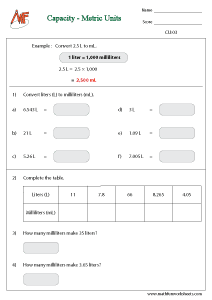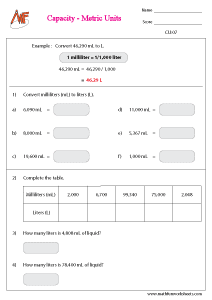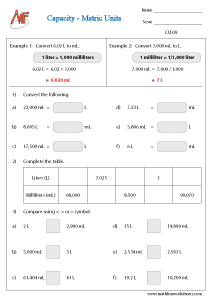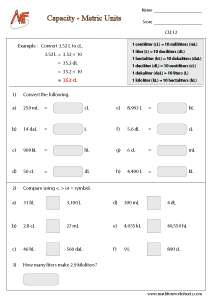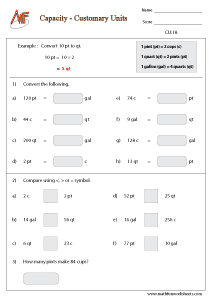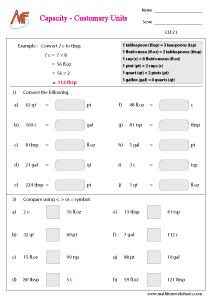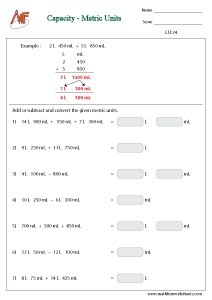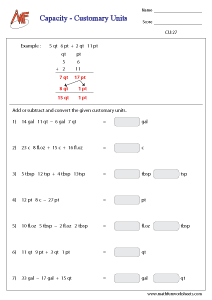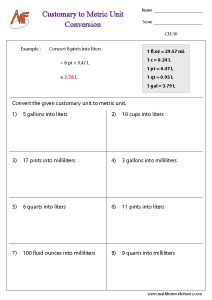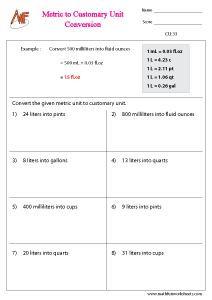- Home
- Measurement
- Capacity - Metric and Customary Units
Browse by Topics
- English Worksheets
- Kid's Corner
- Numbers & Operations
- Addition
- Subtraction
- Multiplication
- Division
- Decimals
- Place Value
- Roman Numerals
- Skip Counting
- Odd & Even Numbers
- Patterns
- Cardinal & Ordinal Numbers
- Rounding Numbers
- Estimation of Numbers
- Estimation of Time & Money
- Counting & Cardinality
- Comparing Numbers
- Ordering Numbers
- Fractions
- Prime & Composite Numbers
- Squares & Cubes
- Divisibility Rules
- Factors & Multiples
- Data Handling
- Algebra
- Ratio
- Proportion
- Order of Operations
- Scientific Notation
- Exponents
- Algebraic Expressions
- Evaluating Algebraic Expressions
- Simplifying Algebraic Expressions
- Graphing Lines
- Point Slope Form
- Two Point Form
- Two Intercept Form
- Equations
- Identifying Functions
- Evaluating Functions
- Function Table
- Domain and Range
- Trigonometric Charts
- Quadrants
- Polynomials
- Measurement
- Geometry
- Word Problems
Capacity - Metric and Customary Units Worksheets
Capacity – metric and customary units worksheets help students learn how to measure and compare liquid volumes in two systems. In the metric system, units like milliliters and liters are used. In the customary system, common units include cups, pints, quarts, and gallons. These worksheets offer structured practice to help learners understand both systems and switch between them easily.
To begin, students get familiar with basic units. For example, they learn that 1 liter equals 1,000 milliliters. In the customary system, they discover that 1 gallon equals 4 quarts. These simple facts form the foundation for accurate conversions. Worksheets often include charts and visual aids to support learning.
Next, students apply their knowledge to real-world problems. They solve questions about recipes, containers, and liquid measurements in daily life. These activities make math meaningful. For instance, a student might figure out how many cups are in a large bottle of juice. As a result, they gain confidence using capacity in practical situations.
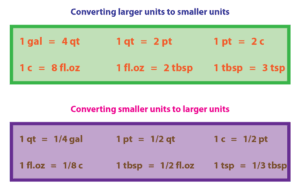
In addition, many worksheets use engaging formats like matching, fill-in-the-blanks, and word problems. These varied tasks keep learning fun and interactive. Transitioning from simple identification to problem-solving helps build strong math skills step by step.
Capacity - Metric and Customary Units Worksheets free download pdf
Convert Liters (L) to milliLitres (mL)

Convert Liters (L) to milliLitres (mL)
Convert milliLiters (mL) to Litres (mL)

Convert milliLiters (mL) to Litres (mL)
Convert milliLiters (mL) to Litres (mL) and vice-versa

Convert milliLiters (mL) to Litres (mL) and vice-versa
Conversion - tbsp, tsp, and fl-oz

Conversion - tbsp, tsp, and fl-oz
Conversion - c, pt, qt, and gal

Conversion - c, pt, qt, and gal
Add / Subtract - Customary units

Add / Subtract - Customary units
Convert Metric to Customary units

Convert Metric to Customary units
Convert Customary to Metric units

Convert Customary to Metric units
Moreover, these worksheets are perfect for classroom lessons, homework, or extra practice. Teachers can easily integrate them into any math curriculum. Parents can also use them at home for extra support.
In conclusion, these worksheets provide a clear and effective way for students to master volume measurement. They build essential skills with simple explanations, real-life examples, and hands-on activities. With regular practice, students become skilled at measuring, comparing, and converting units in both systems. These worksheets make learning capacity simple, engaging, and practical.


